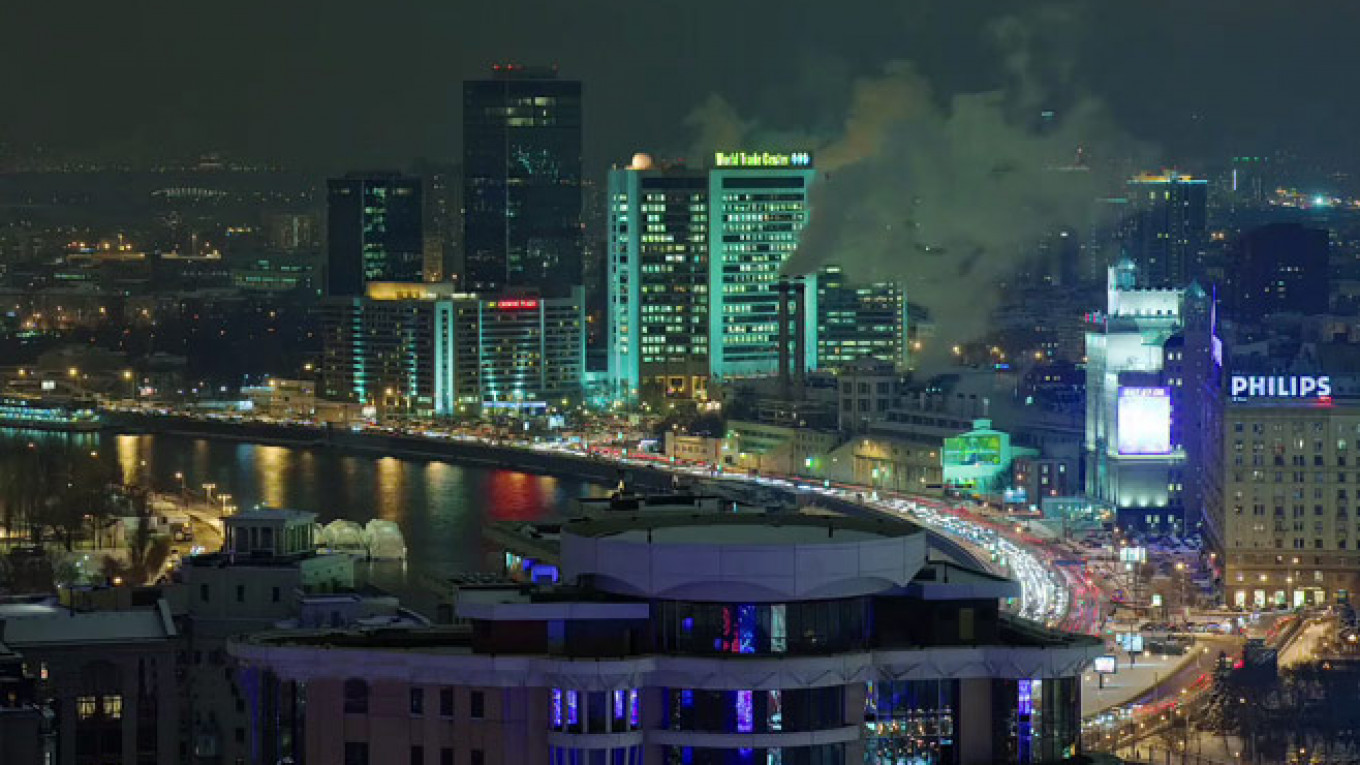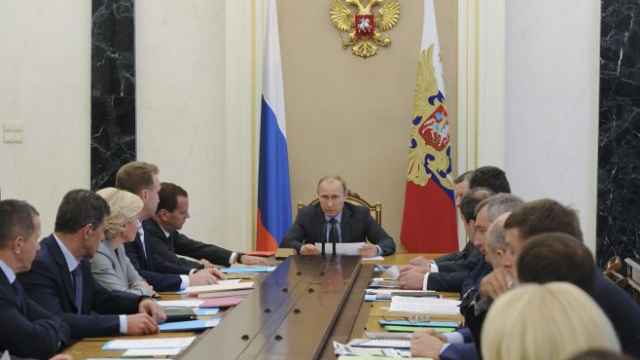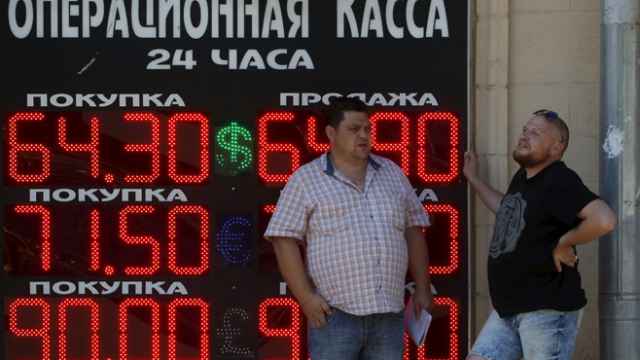Those promoting good news from Russia are focused on the fact that Russia's equity indices are among the best performing in the world this year. The RTS Index is up 11 percent while MICEX is 18 percent ahead of where it started the year. That compares with a loss of 16 percent for the MSCI Emerging Markets Index (MSCI EM) and a drop of 4.5 percent for the U.S. S&P 500 index.
The bad news is that the main reason the indices have performed relatively well is because valuations were already very low coming into this year as foreign investors, i.e. those who did not need to have Russian exposure, had long since departed. So that combination of relatively few active investors and cheap valuations meant that the indices have basically been drifting with low volumes.
Taken over the past five years, the U.S. dollar-denominated RTS is down 45 percent while ruble-based MICEX is up 22 percent or slightly ahead of the 20 percent rise in China's benchmark Shanghai Composite Index in the same period. The quick conclusion is that, smoothing out the volatility of the past few years, Russian equity indices have largely followed EM peers but with the major difference being the ruble devaluation hit on the dollar priced indices. In other words, the oil price impact.
That five-year period covers the U.S. Fed's quantitative easing program during which there has been steady hemorrhaging of liquidity from the emerging market asset class into U.S. equities. The result has been that the S&P 500 Index was the best major equity index in that period with a 75 percent gain.
There is an obvious contradiction in this year's relatively good market performance with the fact that the economy has slipped into recession. In reality there is no contradiction because equity investors mostly deal with anticipation rather than wait to react to facts. Markets are usually out of sync with economics.
So, taking all of that into account, what should equity investors be doing now or, for those of a more cautious disposition, what should they be watching most closely as an early indicator that a more sustainable rally in Russia's equity indices may be in the offing?
It would be no surprise if, at this stage, a large number of skeptics are thinking that such a notion as buying equity risk in Russia today is ridiculous. History suggests otherwise. The big decision an investor has to make is whether there is a bigger risk of valuations becoming cheaper or of a knee-jerk move higher.
Currently, Russian equities are trading at a discount of 50 percent relative to the MSCI EM average. That discount is less, at 40 percent, when the always discounted oil and gas stocks are excluded. There is a lot of bad news and poor expectations built into the market discount. One would have to be unusually pessimistic to assume that valuation gap gets much bigger.
The issue is that when such a thinly traded and tightly held market, as Russia has now become, jumps it can do so very quickly and certainly more quickly than a majority of investors can react. We saw that in the first half of 2009 when the RTS Index doubled between end January and early June even as the economy slipped further into recession.
That was the anticipation effect as investors reacted to the bottoming of the oil price and started to price in the earnings recovery expected in 2010. It basically means that if investors are less fearful of a further big fall in valuations than they are of losing the first leg of a big rally then they need to be very focused on the few big issues which can lead to that knee-jerk move higher.
So, what are the factors that can have that propulsion effect? I suggest the best way to consider the question is via valuation bands; what events may move the equity market to different levels of risk perception?
The three categories are a) what can eliminate the exceptional risk premium which widened the valuation gap from a more usual 35 percent to 50 percent from late 2013? b) what can return the valuation gap back to the 20-25 percent range it traded at before the 2013 growth slowdown? and c) what are the circumstances which could eliminate the valuation gap entirely?
For the first of those questions only two factors matter; the oil price and when financial sector sanctions may start to be eased. Positive movement in either would produce the first knee-jerk reaction and move the market back to the middle-valuation band while of course a further worsening for either would further depress sentiment, albeit with only limited downside movement because negative scenarios are already largely priced in.
Cutting that down to even earlier indicators means focusing on the supply trend for oil and whether the currently hopeful signs of extending the cease-fire in eastern Ukraine hold and lead to further talks with the aim of delivering a workable longer-term deal. Any sign of a cut in oil supply, especially from the U.S. shale sector, or an agreement to start a new round of peace talks, would be very quickly reflected with a tightening of the valuation gap.
An oil price rally and/or optimism that the financial sector sanctions may start to be withdrawn by the middle of next year would take the equity market out of the "sin-bin" but to restore valuations to the longer-run average will need optimism that earnings can again start to grow. That means there will have to be an assumption that the recession will only last one year and even modest recovery can be delivered next year and in 2017.
Forward momentum in the earnings can further reduce the valuation gap, albeit not without the pre-condition of oil price recovery — or stability at or above the $50 per barrel level — plus a re-opening of international capital markets to Russian borrowers. Hence the trend in the monthly macro indicators will also have to show that the recession did indeed bottom in the 2nd and 3rd quarters.
So, an oil price rally and sanctions easing plus positive macro trend indicators, even if modest, are all capable of getting the valuation gap back to where it started. To make the final leap to the third valuation band, i.e. close to parity with EM peers, will require real solid evidence that this is the crisis which starts to shake the Kremlin's policy complacency and leads to some deliverable changes to the economy and to industrial policy.
The last time the market reached the parity valuation band was in May 2008 when the leadership transition generated a lot of optimism about reforms, etc. That turned out to be not much more than smoke and mirrors and was easily blown away when the oil price collapsed over the following seven months. Next time investors will want to see solid evidence of change if they are to push valuations out of the discount bands.
Chris Weafer is a senior partner with Macro Advisory, a consultancy advising international companies and investors working in Russia and across the Eurasia region.
A Message from The Moscow Times:
Dear readers,
We are facing unprecedented challenges. Russia's Prosecutor General's Office has designated The Moscow Times as an "undesirable" organization, criminalizing our work and putting our staff at risk of prosecution. This follows our earlier unjust labeling as a "foreign agent."
These actions are direct attempts to silence independent journalism in Russia. The authorities claim our work "discredits the decisions of the Russian leadership." We see things differently: we strive to provide accurate, unbiased reporting on Russia.
We, the journalists of The Moscow Times, refuse to be silenced. But to continue our work, we need your help.
Your support, no matter how small, makes a world of difference. If you can, please support us monthly starting from just $2. It's quick to set up, and every contribution makes a significant impact.
By supporting The Moscow Times, you're defending open, independent journalism in the face of repression. Thank you for standing with us.
Remind me later.








